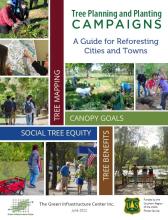The benefits of trees
Trees can provide many benefits in gardens and in urban environments.
They produce fruit, like apples, peaches and figs, and also provide shade and wildlife habitat.
Food forests support forest ecosystems and connect communities with nature. Trees of different sizes produce nuts and fruit, while their shade can support a variety of fresh, flavorful mushrooms, herbs, and berries. Trees also improve air quality and retain water.
Check out the new Tree Planning and Planting Guide: A Guide for Reforesting Cities and Towns, produced by U.S. Forest Service and partner, the Green Infrastructure Center.
The online guide includes a tool to guide communities on where to plant trees to maximize urban cooling across an entire city.
Did You Know?
Oak trees provide more than shade and food for wildlife, their acorns can also be used to produce flour!
By connecting schools to food forests, children can learn about the food they eat and help select and plant trees and shrubs.

